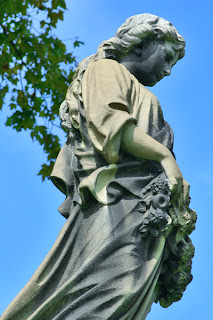I’d long thought that Christ Church Burial Ground in
Philadelphia was government-run, and therefore I figured it might be closed due
to the current government shutdown. Nearby Independence Hall and the Liberty
Bell are both closed as they are operated by the National Park Service (even
the Park Service’s website is down!). Naturally, I was wrong. Turns out that
the historic burial ground is run by, surprise, surprise: Christ Church. And it
was open today, Columbus Day, a legal holiday. (See link at end for list of
what is open and what is closed in Philly during the federal government
shutdown.)
Christ Church is the only cemetery I’ve ever visited that
charges admission. Yes, two dollars (as of October, 2013) to get in. It’s right
across Arch Street from the Philadelphia Mint, so the fact that you have to pay
money to see an historic national landmark that’s right across the street from
where they make the nation’s money is kind of ironic.
I’d always been put off by the admission fee, but I suppose
this is a more palatable way for the Episcopal Church to make money from its
cemeteries than to actually LEASE them like the Roman Catholic Church is doing with
its cemeteries in the Philadelphia Archdiocese (
see link). The saving grace of
Christ Church Burial Ground (established in 1719) is that Ben Franklin’s grave is
visually accessible through the iron fence near the corner of Fifth and Arch Streets.
So you don’t actually have to pay to see Benjamin and Deborah Franklin’s grave
marker.
People throw pennies on his
large, flat stone (“
A penny saved is a penny earned,” Franklin said) and today,
I even heard someone saying to his daughter, “
Make a wish.”
 |
| School children tossing pennies on Ben Franklin's grave (Christ Church Burial Ground) |
I suppose the Church scoops up all the pennies each day and puts
them to good use. The fact that we can see, touch, and walk amidst these
historic graves is a tribute to the Church’s commitment to historic preservation.
According to its
website: “
the Burial Ground was closed to the public from 1977
through 2003. In 2002, The Christ Church
Preservation Trust undertook a major program of renovation in order to reopen
the Burial Ground.”
There’s a tourist booth just inside the entrance gate where
they sell books about the cemetery, and about our nation’s history as it
relates to the few blocks around this area. Five signers of the Declaration of
Independence are buried here, including Dr. Benjamin Rush. Dr. Philip Syng
Physick (the “Father of Modern Surgery”) and George Ross (Betsy’s uncle), along
with various Biddles, Bainbridges, and other historic names from our nation’s
founding. (Wait – one of the Beatles is buried here too...?!) Unfortunately, you’d be
hard-pressed to make out any inscriptions on the headstones. Most are smallish
marble markers that have been worn smooth by acid rain. Bronze plaques now
stand in front of the more famous headstones.
And speaking of printing, Franklin’s grave is by far the
most popular, with people flocking to it with cameras and pennies in hand. A
bronze plaque hangs on the brick wall near the grave. On it is the epitaph Frankin’s
wrote for himself:
"The Body of
B. Franklin,
Printer;
Like the
Cover of an old Book,
Its Contents
torn out,
And stript
of its Lettering and Gilding,
Lies here,
Food for Worms.
But the Work
shall not be wholly lost:
For it will,
as he believ’d, appear once more,
In a new
& more perfect Edition,
Corrected
and amended
By the
Author."
Once I had backed up and was leaning on a crypt cover in
order to get a longer view of the Franklins’ grave, when a guard ran over to me
and asked me not to lean on the other monuments. I was a bit annoyed, thinking
at the time, “
This guy thinks this place is a museum!” But in retrospect, it
is. And since that time I have witnessed a headstone falling on someone, so
maybe safety was on his mind too.

Supposedly 4,000 people are buried in this 2-acre plot of
ground. Interesting number, since an acre today typically holds 1200 to 1500
side-by-side graves. How did they jam in the extra thousand? Did they bury them
standing up? Without burial vaults? At various depths? ? AND ….
this is
still an active burial ground! My
guess is that things have probably disintegrated below ground to the point
where there’s probably nothing left of the 300-year-old wooden coffins,
allowing room for additional burials. As you walk through the place, you do get
the sense that it is rather dense with grave markers and headstones. Still, things were artfully arranged - I like the
way these large flat crypt covers in the image below line the walkway from the gate off Fifth
Street.
 |
| Crypts line walkway of Christ Church Burial Ground, Philadelphia |
 |
| Outside Christ Church |
If you visit, you may notice there’s no church here. So
where is Christ Church? It’s actually two blocks away, near Second and Market
Streets. It has a tiny graveyard surrounding the church, and the additional
land at Fifth and Arch was purchased to expand the burial ground when the
church property filled up. The church still has George and Martha Washington’s
pew box roped off, where they sat during services. Other early American
notables were parishioners of Christ Church, a veritable Who’s Who of the American Revolution:
Betsy Ross, John Adams, Absalom Jones, and the
Franklins, to name but a few.
References and Further Reading:

































